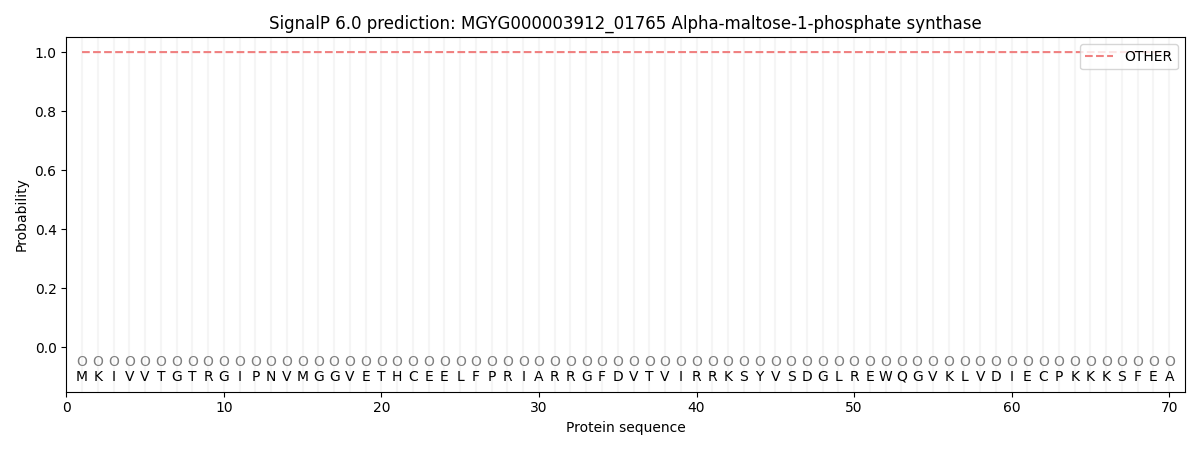You are browsing environment: HUMAN GUT
CAZyme Information: MGYG000003912_01765
You are here: Home > Sequence: MGYG000003912_01765
Basic Information |
Genomic context |
Full Sequence |
Enzyme annotations |
CAZy signature domains |
CDD domains |
CAZyme hits |
PDB hits |
Swiss-Prot hits |
SignalP and Lipop annotations |
TMHMM annotations
Basic Information help
| Species | Prevotella sp000435635 | |||||||||||
|---|---|---|---|---|---|---|---|---|---|---|---|---|
| Lineage | Bacteria; Bacteroidota; Bacteroidia; Bacteroidales; Bacteroidaceae; Prevotella; Prevotella sp000435635 | |||||||||||
| CAZyme ID | MGYG000003912_01765 | |||||||||||
| CAZy Family | GT4 | |||||||||||
| CAZyme Description | Alpha-maltose-1-phosphate synthase | |||||||||||
| CAZyme Property |
|
|||||||||||
| Genome Property |
|
|||||||||||
| Gene Location | Start: 47617; End: 48702 Strand: - | |||||||||||
CDD Domains download full data without filtering help
| Cdd ID | Domain | E-Value | qStart | qEnd | sStart | sEnd | Domain Description |
|---|---|---|---|---|---|---|---|
| cd03801 | GT4_PimA-like | 1.07e-54 | 2 | 358 | 1 | 366 | phosphatidyl-myo-inositol mannosyltransferase. This family is most closely related to the GT4 family of glycosyltransferases and named after PimA in Propionibacterium freudenreichii, which is involved in the biosynthesis of phosphatidyl-myo-inositol mannosides (PIM) which are early precursors in the biosynthesis of lipomannans (LM) and lipoarabinomannans (LAM), and catalyzes the addition of a mannosyl residue from GDP-D-mannose (GDP-Man) to the position 2 of the carrier lipid phosphatidyl-myo-inositol (PI) to generate a phosphatidyl-myo-inositol bearing an alpha-1,2-linked mannose residue (PIM1). Glycosyltransferases catalyze the transfer of sugar moieties from activated donor molecules to specific acceptor molecules, forming glycosidic bonds. The acceptor molecule can be a lipid, a protein, a heterocyclic compound, or another carbohydrate residue. This group of glycosyltransferases is most closely related to the previously defined glycosyltransferase family 1 (GT1). The members of this family may transfer UDP, ADP, GDP, or CMP linked sugars. The diverse enzymatic activities among members of this family reflect a wide range of biological functions. The protein structure available for this family has the GTB topology, one of the two protein topologies observed for nucleotide-sugar-dependent glycosyltransferases. GTB proteins have distinct N- and C- terminal domains each containing a typical Rossmann fold. The two domains have high structural homology despite minimal sequence homology. The large cleft that separates the two domains includes the catalytic center and permits a high degree of flexibility. The members of this family are found mainly in certain bacteria and archaea. |
| COG0438 | RfaB | 1.84e-41 | 1 | 361 | 1 | 378 | Glycosyltransferase involved in cell wall bisynthesis [Cell wall/membrane/envelope biogenesis]. |
| cd03808 | GT4_CapM-like | 9.76e-38 | 11 | 352 | 5 | 356 | capsular polysaccharide biosynthesis glycosyltransferase CapM and similar proteins. This family is most closely related to the GT4 family of glycosyltransferases. CapM in Staphylococcus aureus is required for the synthesis of type 1 capsular polysaccharides. |
| cd03809 | GT4_MtfB-like | 5.65e-37 | 2 | 353 | 1 | 360 | glycosyltransferases MtfB, WbpX, and similar proteins. This family is most closely related to the GT4 family of glycosyltransferases. MtfB (mannosyltransferase B) in E. coli has been shown to direct the growth of the O9-specific polysaccharide chain. It transfers two mannoses into the position 3 of the previously synthesized polysaccharide. |
| cd03819 | GT4_WavL-like | 1.24e-35 | 14 | 329 | 9 | 318 | Vibrio cholerae WavL and similar sequences. This family is most closely related to the GT4 family of glycosyltransferases. WavL in Vibrio cholerae has been shown to be involved in the biosynthesis of the lipopolysaccharide core. |
CAZyme Hits help
| Hit ID | E-Value | Query Start | Query End | Hit Start | Hit End |
|---|---|---|---|---|---|
| QUT84505.1 | 5.28e-206 | 1 | 361 | 1 | 361 |
| QJR77151.1 | 1.51e-205 | 1 | 361 | 1 | 361 |
| AII63545.1 | 1.51e-205 | 1 | 361 | 1 | 361 |
| QEW36414.1 | 3.05e-205 | 1 | 361 | 1 | 361 |
| ALK85623.1 | 9.04e-205 | 1 | 361 | 2 | 362 |
PDB Hits download full data without filtering help
| Hit ID | E-Value | Query Start | Query End | Hit Start | Hit End | Description |
|---|---|---|---|---|---|---|
| 5N7Z_A | 2.05e-09 | 142 | 336 | 133 | 328 | glycosyltransferasein LPS biosynthesis [Salmonella enterica subsp. enterica serovar Typhimurium str. LT2],6Y6G_A Chain A, Lipopolysaccharide 1,6-galactosyltransferase [Salmonella enterica subsp. enterica serovar Typhimurium str. LT2] |
| 5N80_A | 2.06e-09 | 142 | 336 | 134 | 329 | glycosyltransferaseLPS biosynthesis in complex with UDP [Salmonella enterica subsp. enterica serovar Typhimurium str. LT2] |
| 6Y6I_A | 2.07e-09 | 142 | 336 | 135 | 330 | ChainA, Lipopolysaccharide 1,6-galactosyltransferase [Salmonella enterica subsp. enterica serovar Typhimurium str. LT2] |
Swiss-Prot Hits download full data without filtering help
| Hit ID | E-Value | Query Start | Query End | Hit Start | Hit End | Description |
|---|---|---|---|---|---|---|
| P54490 | 1.07e-10 | 87 | 298 | 73 | 281 | Uncharacterized glycosyltransferase YqgM OS=Bacillus subtilis (strain 168) OX=224308 GN=yqgM PE=3 SV=2 |
| P87172 | 1.09e-10 | 16 | 358 | 11 | 363 | Phosphatidylinositol N-acetylglucosaminyltransferase gpi3 subunit OS=Schizosaccharomyces pombe (strain 972 / ATCC 24843) OX=284812 GN=gpi3 PE=3 SV=1 |
| Q06994 | 1.12e-08 | 142 | 336 | 133 | 328 | Lipopolysaccharide 1,6-galactosyltransferase OS=Salmonella typhimurium (strain LT2 / SGSC1412 / ATCC 700720) OX=99287 GN=rfaB PE=1 SV=2 |
| P71055 | 5.15e-08 | 103 | 308 | 107 | 319 | Putative glycosyltransferase EpsF OS=Bacillus subtilis (strain 168) OX=224308 GN=epsF PE=2 SV=1 |
| B2SUK8 | 1.61e-07 | 86 | 361 | 87 | 370 | GDP-mannose:cellobiosyl-diphosphopolyprenol alpha-mannosyltransferase OS=Xanthomonas oryzae pv. oryzae (strain PXO99A) OX=360094 GN=gumH PE=3 SV=1 |
SignalP and Lipop Annotations help
This protein is predicted as OTHER

| Other | SP_Sec_SPI | LIPO_Sec_SPII | TAT_Tat_SPI | TATLIP_Sec_SPII | PILIN_Sec_SPIII |
|---|---|---|---|---|---|
| 1.000039 | 0.000000 | 0.000000 | 0.000000 | 0.000000 | 0.000000 |
